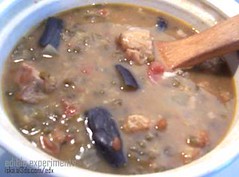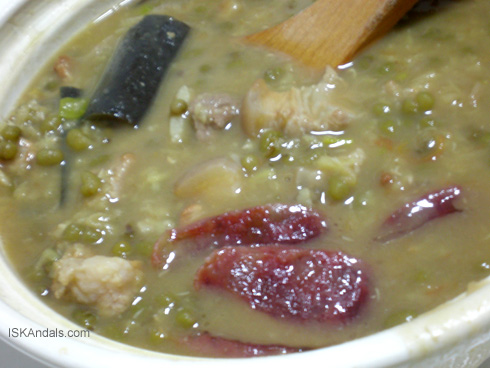 Creamy or soupy, munggo (mung bean) is definitely Pinoy soul food. Cold rainy days and we just love it with fried fish. Summertime and it is still munggo that we crave for. There are also many ways to enjoy it as it could be paired with just about anything – from fried bangus (milkfish) or tilapia and tuyo (dried salted fish) to adobong manok at baboy. You may also add in hibi (dried shrimps), use pata (pork leg) for a flavorful broth or just plain monggo soup sprinkled with chicharon pork cracklings. And just like sinigang na baboy, the veggies I include in it depends on what’s available. Back home, talbos ng ampalaya (bitter gourd tendrils) is a runaway favorite, even dahon ng malunggay (moringa leaves). In Beijing, I can only play around with talong, sitaw and ampalaya (string beans, eggplant and bitter gourd).
Creamy or soupy, munggo (mung bean) is definitely Pinoy soul food. Cold rainy days and we just love it with fried fish. Summertime and it is still munggo that we crave for. There are also many ways to enjoy it as it could be paired with just about anything – from fried bangus (milkfish) or tilapia and tuyo (dried salted fish) to adobong manok at baboy. You may also add in hibi (dried shrimps), use pata (pork leg) for a flavorful broth or just plain monggo soup sprinkled with chicharon pork cracklings. And just like sinigang na baboy, the veggies I include in it depends on what’s available. Back home, talbos ng ampalaya (bitter gourd tendrils) is a runaway favorite, even dahon ng malunggay (moringa leaves). In Beijing, I can only play around with talong, sitaw and ampalaya (string beans, eggplant and bitter gourd).

Mix it with home-made chicharon. . .

Top it with fried daing bought from a tiangge (flea market) at the Worker’s Stadium that tastes exactly like it’s from Manila.

As A likes it, creamy with Chinese chorizo. Oh well I never tried that before until now and it turned out surprisingly delicious!
Ingredients:
2 cups munggo
1/2 kilo pork, cut into tidbits
2 eggplants, cut ala-pakbet
4 medium-sized tomatoes, chopped
1 large onion, chopped
4 tbsp of diced garlic
patis (fish sauce) or salt
Simmer munggo in a pot of water (about 5-6 cups) until the beans soften. Add water if necessary.
In another pan, cook the pork in its own juice with little salt until it renders fat and the meat is brownish. Push the cooked meat to one side and fry the chopped garlic until golden brown. Throw in the onions and tomatoes, add patis and saute until the tomatoes are mashed.
Pour the saute mix to the pot of munggo (or the other way around) and mix well. Adjust the taste. Add the eggplant and simmer until the beans and eggplant are cooked.
Above is how I normally cook munggo guisado (stew) , but I know another way of doing it. When mom does it Dad calls it gawain ng tamad (the lazy man’s way). . .
Simmer munggo and pork in a pot of water for about 30 minutes. Add in the garlic, onions and tomatoes and bring to boil. Add patis and continue cooking until beans soften, tomatoes mashed and pork is tender.






hi iska i likie munggo too, i cook munggo in the rice cooker so i don’t have to make bantay. when i get home in the evening all i have to do is to gisa everything. sometimes i also put sotanghon in the soup.
Hi Iska,
Looks masarap talaga yan! I love the munggo with homemade chicharon the best – nakakagutom!
Wow thanks for sharing this. I’ve never attempted to make munggo guisado. This recipe is very amateur-friendly so I’ve bookmarked it na.
Hi Iska. The version with chorizo, may cream din? Guisa as usual then add cream at the end? I want to try it. My hubby will like it, I’m sure.
It looks lovely ate! It’s been a long time since I ate some monggo beans
Isa kong natikman na luto ng munggo iyong may gata. Masarap din siya.
oh, I have to remember to find some mungo beans next time I’m at the Filipino store! You just made me want some, and I my lone ampalaya plant in my garden may be mature enough to lend some of it’s leaves to my pot soon.
Hi Iska!
hindi pa ako nakakatikim ng guisadong munggo na may talong, mukha ngang masarap!
The Queer Chef pimped me here and I say hello from Norway!
Your blog is great and the soup looks deliseous – I really want to try that one day
Oooh! You know how much I love munggo! And the best part is all the different ways you can make it YUM! You have inspired me to make another batch soon